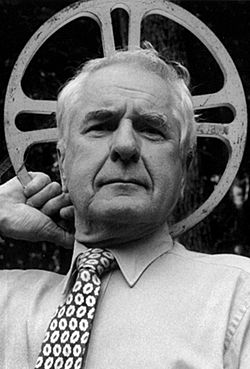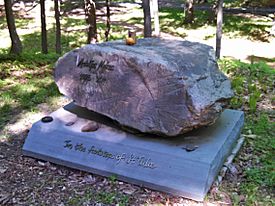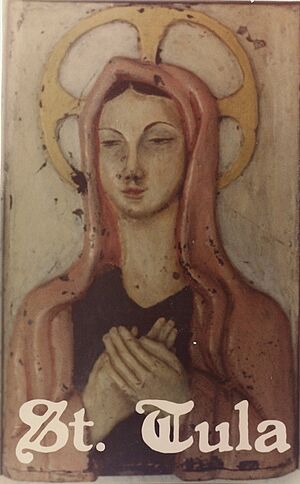Adolfas Mekas facts for kids
Quick facts for kids
Adolfas Mekas
|
|
|---|---|

Filmmaker, educator
|
|
| Born | 30 September 1925 Semeniškiai, Lithuania
|
| Died | 31 May 2011 (aged 85) Poughkeepsie, New York, U.S.
|
| Known for | Cinema |
Adolfas Mekas (born September 30, 1925 – died May 31, 2011) was a talented filmmaker, writer, director, editor, actor, and teacher. He was born in Lithuania and later became an American citizen.
Adolfas, along with his brother Jonas Mekas, started the magazine Film Culture. They also helped create the Film-Makers' Cooperative. He was connected to the Fluxus art movement, which was a group of artists who liked to mix different art forms.
Adolfas Mekas made many short films. His most famous movie was Hallelujah the Hills in 1963. This film was shown at the Cannes Film Festival and is now seen as a classic American movie.
Contents
Early Life and Journey to America
Adolfas Mekas was born on a farm in Semeniškiai, Lithuania. He was the youngest of six children.
When he was 14, Adolfas saw his first movie, Captain Blood. This was in Lithuania. In July 1944, during World War II, Lithuania was occupied by soldiers. Adolfas and his brother Jonas left their home by train. They were worried because they had been part of a secret resistance group.
Near Hamburg, Germany, they were taken from the train. They were forced to work in a labor camp. After the war ended, the brothers moved between different displaced persons camps in Germany. These were camps for people who had lost their homes because of the war.
While in Germany, Adolfas studied literature, theater, and philosophy. He also wrote and published short stories, novels, and books for children. He tried to move to Israel, New Zealand, and Canada, but was not allowed. Finally, he and his brother came to the United States as refugees in late 1949.
Starting a New Life in the United States
In 1950, Adolfas bought a 16mm Bolex camera and started taking photos. He also wrote over 50 movie scripts. He went to many film screenings at places like the Museum of Modern Art.
He worked many different jobs to support himself. These included washing dishes and working in a factory. In 1951, he joined the United States Army during the Korean War. He was part of the Signal Corps and went to France.
When he returned to the U.S. in 1953, he kept writing and filming. He and his brother Jonas also tried to start something called the American Film House. They wanted to create a place for independent filmmakers to work together. But they couldn't find a good location or enough filmmakers who wanted to join.
So, in 1954, they changed their plans. With money they had saved, they started a film society called the Film Forum. They showed films in schools and halls. Even though they ran out of money, they used what was left to start Film Culture magazine. The first issue came out in December 1954.
Film Culture became a place for anyone to share their ideas about movies. Adolfas was the editor of this magazine until 1968.
In the early 1950s, Adolfas and Jonas worked on several films that were never finished. These included Lost, Lost, Lost and Grand Street. These films showed the lives of people who had been displaced or were new immigrants in Brooklyn. In 1953, they made a sad romance called Silent Journey, where Adolfas also acted.
Adolfas also traveled to Canada to find ideas for a novel he was writing. In 1958, he lived in Oaxaca, Mexico for a year. He lived on just $1 a day, which gave him time to write. He finished the script for Hallelujah the Hills there.
In 1960, Adolfas, Jonas, and producer Lew Allen gathered about 20 independent filmmakers. They decided to form a group called the New American Cinema. This led to the creation of the Film-makers' Co-op in 1961. This group helped distribute independent, experimental, and avant-garde films.
Making Movies and More
In 1961, Jonas Mekas started filming Guns of the Trees. Adolfas helped with writing and editing, and he also acted in the movie. This film was seen as an important "poetic-political" statement.
In 1963, Adolfas Mekas's film Hallelujah the Hills was a big hit at the Cannes Festival. It was shown at 27 other film festivals around the world. It won an award at the Locarno Festival and was even shown to the Royal Family at Buckingham Palace. The movie played for 15 weeks in a New York cinema. Critics loved it, with one calling it "the weirdest, wooziest, wackiest screen comedy of 1963."
In 1964, Mekas worked as an editor for the film Goldstein. He helped shape the movie into a unique story.
That same year, Mekas edited a film called The Brig. It was filmed by his brother Jonas during a play performance. This film won an award at the Venice Festival.
In March 1964, Adolfas met Pola Chapelle, who later became his wife. They worked together on many projects. For his second feature film, The Double Barreled Detective Story, they built a special old-fashioned town for the movie set. The film was based on a Mark Twain story. However, Adolfas didn't get to finish editing the movie himself. Even so, he managed to show a version of it at the Venice Film Festival in 1965.
In 1965, Mekas directed Pola Chapelle in a short, funny film for a Broadway show called Skyscraper. Critics praised this three-minute film clip.
Throughout the rest of the 1960s, Adolfas wrote many scripts. He also worked as an editor or coordinator on various independent films and TV shows.
In 1967, Adolfas made a black-and-white film called Windflowers, Elegy for a Draft Dodger. It was a quiet and touching film about a young man running away.
Later in 1967, he was asked by Governor Harold E. Hughes of Iowa to create TV commercials for his election campaign. Even though Adolfas had no experience with commercials, he took on the challenge. He made 35 TV commercials, and Governor Hughes won the election.
In 1968, Mekas wrote, directed, and acted in a short film called Interview with the Ambassador from Lapland. It was a clever and funny film.
He also worked on films about cats! In 1969, he edited Fishes in Screaming Water for the First International CatFilm Festival. In 1973, he made an award-winning film called How to Draw A Cat.
In 1970, he edited Companeras and Companeros, a documentary filmed in Cuba. He also edited a film by Yoko Ono called Up Your Leg.
In 1972, Adolfas completed an autobiographical film called Going Home. This film showed his return to Lithuania after 27 years. It was shown at the New York Film Festival and other festivals. It was even chosen by the Museum of Modern Art to be shown around the world.
Teaching at Bard College

In 1971, Adolfas Mekas started teaching at Bard College. He soon began to build a new Film Department there. He worked hard to make sure the Film Department would be a permanent part of the college. He succeeded, and in 1979, he was granted tenure, which meant he had a permanent teaching position.
Adolfas, Pola, and their son Sean moved to the Hudson Valley. He loved teaching. The Film Department had a very small budget. But Adolfas was creative. Once a year, he and Pola would rent a truck and visit friends in New York City. They would collect film equipment like reels and projectors to bring back to Bard College.
The lack of money actually made Mekas and his students more creative. For example, to raise money for student film projects, he would hold lunchtime auctions on campus. The Film Department started small, but it grew to be very respected. Adolfas brought many famous independent filmmakers and film historians to teach and visit.
One of his colleagues, P. Adams Sitney, said that Mekas was an amazing teacher. He said Adolfas had a "fount of comic invention" and turned his classrooms into "arenas of magic." He taught many students how to see and create.
In 1971, while visiting Italy, Mekas had a vision of a saint. He believed she was the Patron Saint of Cinema. He called her St. Tula. He put her picture in the Film Department, and soon someone wrote under it, "St. Tula loves your film. Even if no one else does." An altar was built for her, and later, "Sayings of St. Tula" were published.
Besides leading the Film Department until 2004, Adolfas also helped start the Milton Avery Graduate School of the Arts at Bard College in 1981. He also taught film courses in New York City and was a guest lecturer at many other schools.
Adolfas Mekas passed away on May 31, 2011. He was working on a film about an old philosopher named Giordano Bruno right up until the end.
Partial Filmography
- Lost, Lost, Lost (1950) with brother Jonas, unfinished
- Grand Street (1951) with brother Jonas, unfinished
- Silent Journey (1953) with brother Jonas, unfinished
- Antifilm #2 (1953)
- Inca (1954) lost
- Film Essay (1955) with brother Jonas, unfinished
- Sunday Junction (1958) with brother Jonas, unfinished
- Guns of the Trees (1961)
- Hallelujah The Hills (1963)
- Goldstein (1964) editor
- The Brig (1964)
- The Double Barreled Detective Story (1965)
- Skyscraper (1965)
- The Swap and How They Make It (1966) editor, post production coordinator & trailers ("hot" & "cool" versions)
- The Love Merchant (1966) editor
- Mimi Benzell (1966)
- Building for the Future (1966)
- A Matter of Baobab (1966)
- Step Out of Your Mind (1966) editor
- Windflowers – Elegy for a Draft Dodger (1967)
- Hawaii Ho! (1968) editor & post production coordinator
- Interview with the Ambassador from Lapland, Time-Life Newsreel (1967)
- Sweet Victory (1968)
- Fishes in Screaming Water (969) editor
- Companeros and Companeras (1970)
- A Matter of Baobab, First Growth (1970)
- Those Memory Years (1970) editor
- A Weekend With Strangers (1970) editor
- Up Your Leg (Yoko Ono in 1970) editor
- A Science Fiction Film in the Latter Twentieth Century (1971) production manager
- Going Home (1972)
- How to Draw a Cat (1973)
Published Works
- Mekas, Adolfas, and Jonas Mekas. Is Pasaku Krasto: Rinktines Ivairiu Tautu Pasakos. Vilnius: Dominicus Lituanus, 2013. Print.
- "In August 2009…" 222 autobiographies de Robert Kaplan by his friends – page 469. Association Locus Solus, 2011
- Idylls of Semeniskiai – Adolfas translated from Lithuanian to English this epic poem by Jonas. Hallelujah Editions 2007
- When the Turtles Collapse by Adolfas Mekas and Pola Chapelle, 1999 Hallelujah Editions 2005
- Nailing the Coffin, by Adolfas Mekas and Jonathan Shipman, 1981 Hallelujah Editions 2005
- The Father, the Son and a Holy Cow by Adolfas Mekas, 1999 Hallelujah Editions 2005
- Hallelujah les Collines (screenplay of "Hallelujah the Hills") L'Avant Scene, No. 64, 1966.
- Soldiers Fought Bravely to Enter the city. (Short story) Bread&, No 2, 1962; Motive, Vol XXII, No. 3, 1962
- "A Letter From Mexico or a Film Between Two Mafias." Film Culture 20 (1959): 72–79. Print.
- Chapter XV. (Excerpt from a novel.) Bread&, No 1, 1958.
- Proza II. Collected short stories. Gabija, 1951, in Lithuanian. (from 1945–52 published numerous literary and journalistic articles in various Lithuanian periodicals)
- Proza I. Collected short stories. Zvilgsniai, 1949, in Lithuanian.
- Une Reverence. Poems in prose. Zvilgsniai, 1948, in Lithuanian.
- Knyga Apie Karalius ir Zmones (A Book About Kings and People). Collected short stories. Patria, 1947, in Lithuanian; published again by Humanitas in 1994.
- Is Svetimo Krasto (From a Foreign Country). Stories for children. Giedra, 1947, in Lithuanian.
- Trys Broliai (Three Brothers). Stories for children. Giedra, 1946, in Lithuanian.
See Also
- Bibliography of works on Adolfas Mekas


